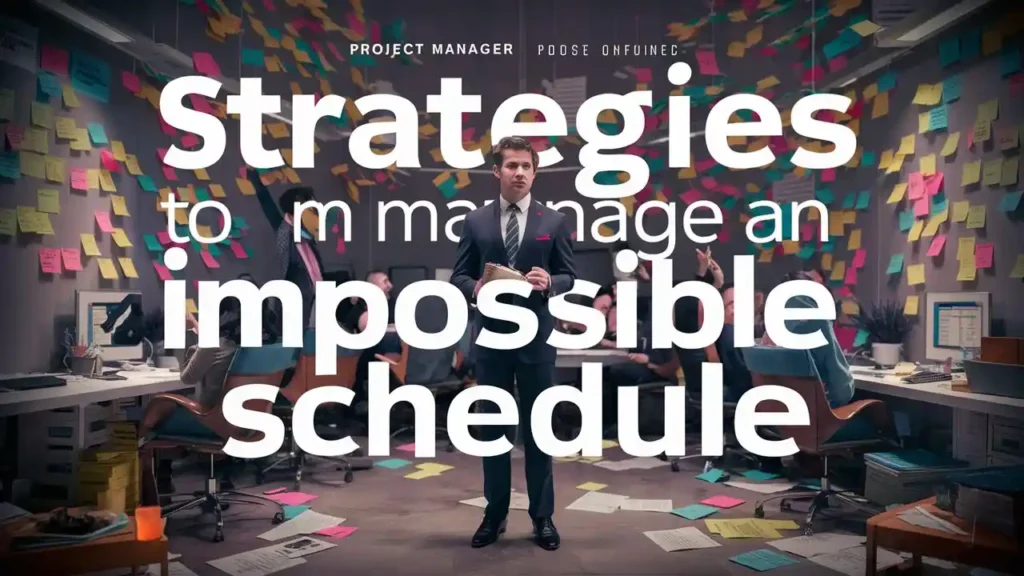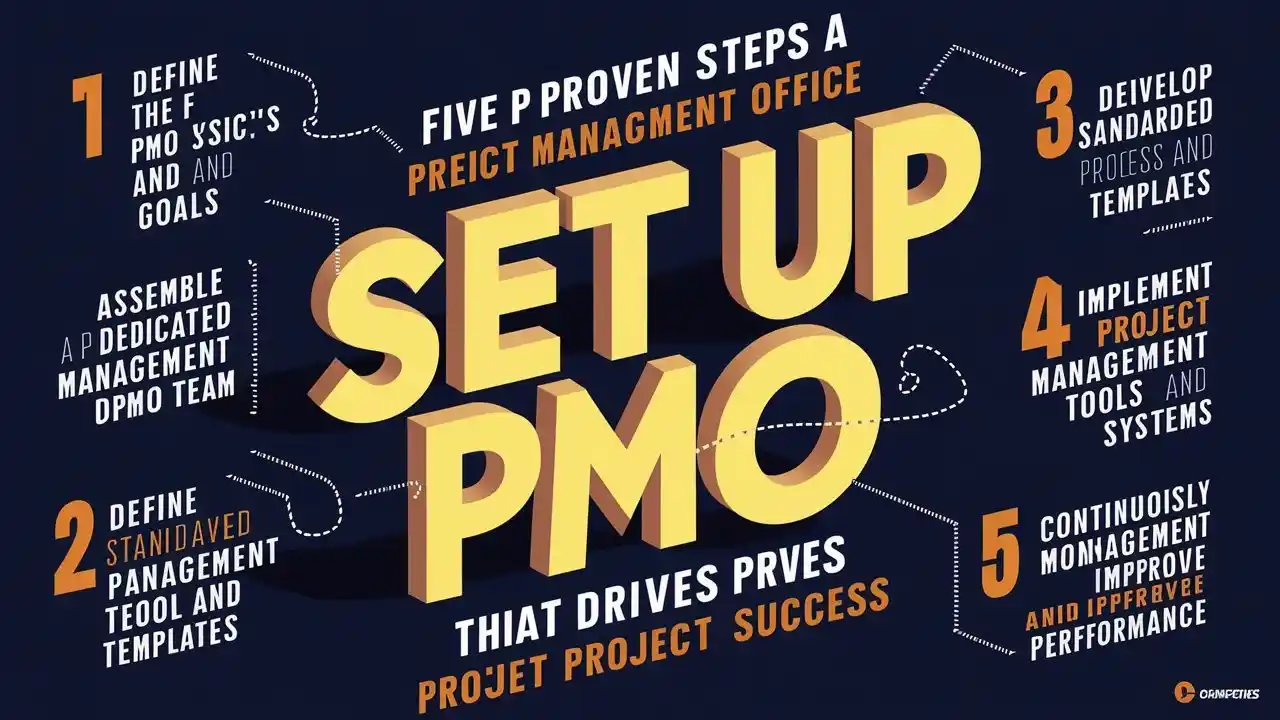Introduction
In the world of project management, dealing with impossible schedules is a reality that many professionals face. When deadlines are unrealistic and resources are stretched thin, it can feel like you’re fighting an uphill battle. Yet, with the right strategies, even the most daunting timelines can be managed effectively. This blog is tailored for project managers who are forced to navigate impossible schedules and need practical, actionable strategies to regain control. In this blog we discover 7 Game-Changing Strategies to Manage an Impossible Schedule as a Project Manager
Actionable Tip: Begin by conducting an honest assessment of your current project schedule. Identify critical tasks and potential bottlenecks—it’s the first step towards reclaiming your timeline.
1. Understanding the Impossible Schedule
Before diving into strategies, it’s crucial to understand why project managers often find themselves battling impossible schedules. This section sets the stage by exploring the inherent challenges and their impacts.
1.1 The Nature of Unyielding Timelines
Project schedules are often deemed “impossible” due to unrealistic expectations set by clients, aggressive market demands, or internal miscommunications. These timelines leave little room for error and can quickly escalate into crises if not managed properly. Recognizing that these challenges are systemic rather than personal can help you reframe your approach.
1.2 Impact on Team Morale and Project Outcomes
An impossible schedule can sap team morale, leading to burnout, reduced productivity, and ultimately, subpar project deliverables. Teams under constant pressure may cut corners or miss critical quality checks, resulting in a product that fails to meet client expectations. Acknowledging the toll on your team is the first step in implementing strategies to mitigate these effects.
1.3 Success Story: Overcoming Extreme Deadlines
Consider the case of a mid-sized tech company tasked with delivering a complex software solution in just eight weeks—a timeline that initially appeared unattainable. By realigning priorities, streamlining communication, and adopting agile practices, the project manager not only met the deadline but also exceeded client expectations. This success story demonstrates that even the most impossible schedules can be conquered with the right approach.
2. 7 Game-Changing Strategies for Schedule Management
Below are seven essential strategies that have proven effective in managing impossible schedules. Each strategy is designed to address specific challenges and is supported by practical tips and real-world examples.
2.1 Prioritize Ruthlessly
Key Concepts:
Identify Critical Tasks: Use tools like the Eisenhower Matrix to differentiate between urgent and important tasks.
Focus on the Critical Path: Determine which tasks directly impact your project’s delivery date and allocate resources accordingly.
Actionable Advice:
Start your day by identifying the top three tasks that are absolutely critical to your project’s success. This ensures that even if unexpected issues arise, the most important tasks are already in motion.
2.2 Adopt Time Blocking Techniques
Key Concepts:
Structured Time Management: Allocate specific blocks of time to different tasks or phases of the project.
Enhanced Focus: Dedicating uninterrupted time to critical tasks minimizes distractions and improves productivity.
Actionable Advice:
Implement time blocking in your calendar. For example, reserve morning hours for strategic planning and afternoons for team check-ins and progress reviews. This structure can significantly improve your time management.
2.3 Optimize Resources and Delegate Effectively
Key Concepts:
Resource Allocation: Understand the strengths and weaknesses of your team members.
Delegation: Delegate tasks to those best suited to handle them, freeing up your time for high-priority activities.
Actionable Advice:
Conduct a skills assessment of your team and delegate tasks based on individual strengths. This not only improves efficiency but also boosts team morale by ensuring members are engaged in work that fits their expertise.
2.4 Leverage Agile and Lean Methodologies
Key Concepts:
Iterative Planning: Break your project into manageable sprints and conduct regular reviews.
Continuous Improvement: Use feedback loops to adjust and improve processes as the project evolves.
Actionable Advice:
Transition to an agile approach by incorporating daily stand-ups and sprint reviews. This methodology enables you to adapt quickly to changes and better manage deadlines.
2.5 Embrace Digital Tools and Software
Key Concepts:
Project Management Tools: Utilize software such as Microsoft Project, Asana, or Trello to track progress and deadlines.
Automation: Automate routine tasks to free up valuable time for strategic activities.
Actionable Advice:
Integrate a digital project management tool that suits your workflow. Customize dashboards to monitor key performance indicators (KPIs) and project milestones in real time.
2.6 Maintain Transparent Communication
Key Concepts:
Regular Updates: Keep all stakeholders informed about progress, setbacks, and any changes to the project schedule.
Open Dialogue: Encourage team members to voice concerns and offer suggestions.
Actionable Advice:
Establish a regular communication cadence—such as weekly status meetings or daily check-ins—to ensure everyone is aligned and aware of project updates. Transparency builds trust and helps preempt potential issues.
2.7 Conduct Regular Post-Project Reviews
Key Concepts:
Learning from Experience: Analyze what went well and what didn’t to improve future project planning.
Process Refinement: Use insights from past projects to streamline processes and avoid repeating mistakes.
Actionable Advice:
After completing a project, hold a debrief session with your team. Document key learnings and integrate these insights into future project plans. This practice is invaluable for continuous improvement.
3. Real-World Scenario: The Impossible State-Deadline Challenge
The Scenario
One project manager recently shared a deeply challenging scenario:
“I just need to vent with folks who understand. I was a project manager for a private consulting firm before getting a state job where I now supervise people and projects that have an IMPOSSIBLE state-legislated deadline. My small team is tasked with reviewing highly technical and complex plans that are 1,500+ pages, and writing decisions that are 200+ pages, for 9 utility companies all within one calendar year. We are mandated to produce the decisions in a short 3-month time frame from receiving each plan.
This is beyond impossible and we’ve never been able to pull it off in the 3 years I’ve been with the agency. Technically, we can publish a document saying hey, we won’t be able to meet the 3-month turnaround, here’s the new date we’ll have the decisions published. But our Legal Department won’t allow us to do this outright, and waits for us to kill ourselves trying to meet impossible deadlines before approving a formal schedule extension.
We have been working with a PMO to advise and help us apply lessons learned from past years—where were the hold-ups, how long do certain groups actually need to complete their tasks, etc. Now we’re building out the baseline schedule for this year. Executives are directing us to force everything into the 3-month timeline, knowing full well it’s not achievable. We are giving team members 2 days to complete a task that we learned takes 2 weeks… but 2 days is going in the baseline schedule. We will be starting with a false schedule, giving milestones to the team we know for a fact will change, and giving PMO hours and hours of additional work in the weekly and daily schedule adjustments we know will be necessary. So much for applying lessons learned!
It goes so deeply against my grain, it is a waste of time, provides the team incorrect information, and applies pressure to achieve the unachievable. It is so backwards from how to manage projects and schedules.
Also, we are using MS Project and these projects are so long and convoluted I think we’re nearly breaking the system. I thought I hated MS Project before, now I truly loathe it.”
Expert Analysis
As an experienced project manager, several red flags arise from this scenario:
Unrealistic Deadlines:
The mandated 3-month turnaround for reviewing 1,500+ page plans and producing 200+ page decisions is clearly unfeasible. Forcing a timeline that you know is impossible not only sets the team up for failure but also jeopardizes the quality of the work and team morale.False Baseline Schedules:
Incorporating durations that are known to be unrealistic (e.g., scheduling a 2-week task as 2 days) creates a baseline that is misleading from the outset. This “false schedule” misinforms both the team and stakeholders, resulting in perpetual schedule adjustments and increased pressure.Resistance to Schedule Extensions:
The inflexible stance of the Legal Department, combined with executive pressure to meet these deadlines, means that even when lessons learned are available, they are disregarded. This forces the team into a cycle of crisis management rather than proactive planning.Tool Limitations:
Relying on MS Project for such complex and long-duration projects has led to system strain, highlighting that the current project management tools may not be sufficient for the workload.
Suggested Solutions
1. Reframe the Baseline Schedule:
Gather Data and Document Realistic Timelines: Use historical data and lessons learned to create a realistic baseline schedule. Document actual task durations and build a schedule that reflects true capabilities, even if it means proposing schedule extensions.
Develop a Contingency Plan: Integrate contingency buffers into your timeline to accommodate inevitable delays. This protects the team from the stress of constant deadline shifts.
2. Advocate for Process Flexibility:
Engage Stakeholders Early: Arrange meetings with executive leadership and the Legal Department to present data-backed evidence on why the current deadlines are unachievable. Propose alternative timelines or phased deliverables that allow for quality control.
Implement Interim Reporting: Instead of a single final delivery, introduce interim milestones that allow for partial reviews and feedback. This approach can ease the pressure on the team and provide ongoing progress updates to stakeholders.
3. Optimize Resource Allocation:
Reassess Task Durations: Collaborate with your team and the PMO to reallocate tasks based on realistic durations. Adjust the schedule to match the actual pace required for quality review and decision writing.
Leverage Additional Tools: Evaluate whether supplementary project management tools (or additional modules/plugins for MS Project) could better handle the project’s complexity. Consider cloud-based solutions that offer better scalability and collaboration features.
4. Build a Case for Schedule Extensions:
Present a Risk Analysis: Create a comprehensive risk analysis that outlines the potential consequences of adhering to the unrealistic schedule—including quality issues, team burnout, and legal risks. Use this analysis to advocate for formal schedule extensions.
Document Every Adjustment: Keep detailed records of all schedule adjustments and their impacts. This documentation can serve as evidence to support future requests for more reasonable deadlines.
By addressing these challenges with data-driven insights and a proactive approach, you can shift the narrative from reactive crisis management to strategic, sustainable project planning.
4. Conclusion
Managing an impossible schedule is a formidable challenge for any project manager. By prioritizing ruthlessly, adopting time blocking techniques, optimizing resources, and embracing agile methodologies, you can transform seemingly insurmountable deadlines into achievable milestones. The key takeaway is that even under extreme pressure, strategic planning and continuous improvement pave the way for success.
Final Actionable Tip: Today, review your current project schedule. Identify one bottleneck and apply one of the strategies discussed above—whether that’s reworking your baseline or advocating for more realistic deadlines. Small, consistent changes can lead to substantial improvements over time.
5. Additional Resources
- Books:
The Phoenix Project by Gene Kim, Kevin Behr, and George Spafford
Scrum: The Art of Doing Twice the Work in Half the Time by Jeff Sutherland
- Websites & Blogs:
PM Network by PMI
- Tools:
Microsoft Project
Asana
Trello
- Communities:
PMI Global Community
LinkedIn Project Management Groups










